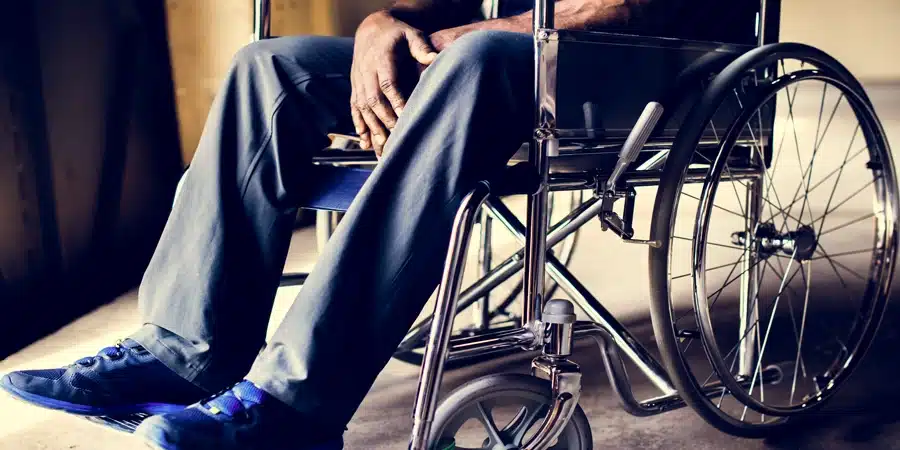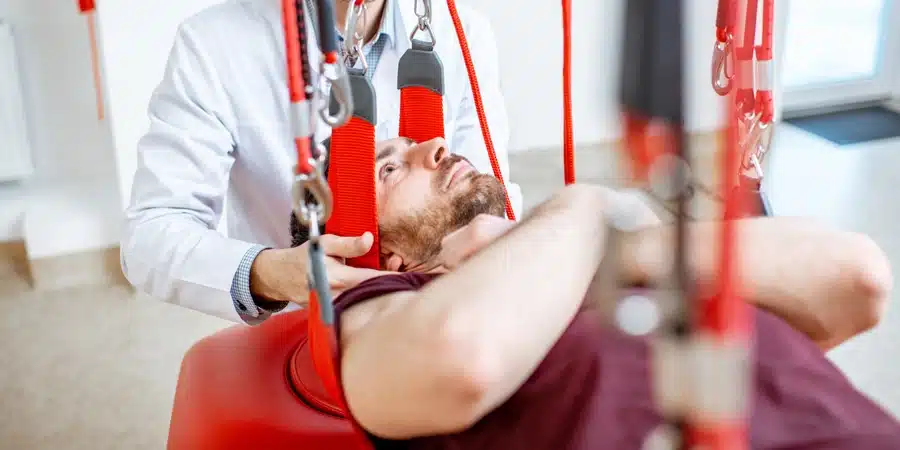Paralysis Lawyer
Some 5.4 million Americans live with some degree of paralysis.
But while stroke remains the leading cause of paralysis in the United States, tens of thousands have also been paralyzed due to catastrophic spinal cord injury sustained in connection with car accidents, medical malpractice, slips and falls and other incidents that resulted from another party’s negligent or reckless behavior.

The Killino Firm’s nationally recognized injury lawyers have extensive experience successfully representing people living with the consequences of paralysis and other traumatic injuries. We understand the life-changing implications such injuries have for our clients and their families, and we work zealously to safeguard their rights and ensure they’re fairly and fully compensated for all their injuries and losses. If you or a loved one suffered a paralyzing injury due to the actions of another, and you’d like to speak with an attorney, please contact our law firm today at 877-875-2927 to learn more about your legal rights and options.
Understanding Paralysis: An Overview
Paralysis is a complex medical condition that significantly impacts an individual’s ability to move or control certain muscles. It typically results from damage to the nervous system that disrupts the signals that travel between the brain and muscle. This type of damage can occur in one of several ways:
- Stroke or other medical event.
- Autoimmune diseases such as Multiple Sclerosis or Guillain-Barre Syndrome
- Neurological disorders, such as amyotrophic lateral sclerosis (ALS)
- Traumatic injuries to the brain or spinal cord.
The onset of paralysis can be gradual or sudden. Symptoms will depend on the part of the body that’s affected and may include:
- Inability to walk
- Loss of standing balance
- Difficulty with fine motor skills
- Inability to bath themselves or handle other activities of daily living
- Altered muscle tone
- Exaggerated reflexes
- Numbness
- Sensitivity to pressure or temperature
- Loss of bowel or bladder control
- Difficulty swallowing
- Difficulty breathing
- Facial droop, drooling, or dry eye
While the loss of motor function caused by conditions like Bell’s Palsey may go away over time, there is currently no cure for paralysis. However, physical, occupational, and speech therapy, along with the use of appropriate adaptive devices, can help improve the quality of life for many people living with paralysis.

Types of Paralysis
There are four main categories of paralysis, each based on the portion of the body affected:
- Monoplegia: This form of paralysis affects a single limb, such as an arm or a leg. It is often associated with localized nerve or muscle damage. Cerebral palsy is the leading cause of monoplegia; however, it is especially common after a stroke or brain injury.
- Hemiplegia: Hemiplegia involves the paralysis of one side of the body, affecting either the right or left side. It often starts with a feeling of “pins and needles” on the affected side, followed by muscle weakness, and then escalates to the total loss of motor function. Some people with hemiplegia experience varying degrees of paralysis from day to day, and it often turns out to be temporary. Cerebral palsy is also the leading cause of hemiplegia.
- Paraplegia: Paraplegia results in the loss of function in the lower half of the body, including the legs. In addition to affecting their ability to walk, people with this form of paralysis may also experience impaired bodily and sexual functioning. Paraplegia is almost always permanent.
- Quadriplegia (Tetraplegia): This is the most extensive form of paralysis, affecting the entire body from the neck down, including all four limbs and the torso. Typically permanent, quadriplegia is the most common symptom of traumatic spinal cord injury, occurring in about 60% of cases. However, certain medical conditions can also cause quadriplegia.
- Diplegia: Diplegia involves the symmetrical paralysis of corresponding parts on both sides of the body, usually affecting the arms or legs. It is commonly associated with conditions like cerebral palsy.
Preventable Causes of Paralysis
Some of the most common preventable causes of paralysis include:
- Motor Vehicle Accidents: The impact of a serious car crash or truck accident can throw, twist, and crush an adult-sized human being, resulting in serious injury to the delicate spinal cord and vertebra. According to the Miami Project to Cure Paralysis, nearly 38 percent of all spinal cord injuries reported in the United States since 2015 were the result of motor vehicle accidents.
- Slips and Falls: Slips and falls were associated with 31 percent of all spinal cord injuries reported since 2015. Direct trauma to the spine—caused by landing on the back or neck — can cause significant damage to the spinal cord that can result in full or partial paralysis.
- Violence: Violent incidents have caused 15% of all spinal cord injuries that have occurred in the United States since 2015. Gunshot wounds are the primary cause of spinal cord injuries resulting from violence.
- Sports-Related Injuries: Since 2015, sports-related injuries have caused just under 9% of all spinal cord injuries reported each year. Diving, horseback riding, skiing and other winter sports are among the activities most likely to be associated with paralyzing injuries.
- Medical Malpractice: According to the Miami Project to Cure Paralysis, medical malpractice has been responsible for 3.6 percent of all spinal cord injuries since 2015. Failing to properly immobilize patients who’ve suffered a traumatic injury, untimely diagnosis of a spinal tumor, misreading tests and diagnostic reports, and mistakes in the delivery room that result in cerebral palsy or other birth injuries are just a few of the medical errors that can potentially result in some degree of paralysis.
- Work Injuries: Potentially paralyzing spinal cord and traumatic brain injuries can occur in the workplace due to motor vehicle crashes and other transportation-related incidents, slips and falls, accidents involving heavy machinery, being struck by an object, or being pinned or crushed between or by heavy equipment. Those most at risk of suffering a paralyzing injury on the job include construction workers, delivery drivers, transportation workers, factory workers, warehouse employees, miners, healthcare workers, and agricultural workers.
The Consequences of Paralysis
The consequences of paralysis typically extend far beyond the loss of mobility, affecting every aspect of an individual’s physical, emotional, and financial well-being.
Medical and Rehabilitative Costs
People with severe forms of paralysis need specialized medical care and rehabilitative services for the entirety of their lives. Home modifications, such as ramps, widened doorways, and accessible bathrooms, are also essential to create an environment conducive to independent living.
The financial burden incurred as a result of these needs is substantial. According to the National Spinal Cord Injury Statical Center (NCISC), the estimated lifetime cost of a spine injury for a 25-year-old with paraplegia exceeds $2.6 million, while the estimated lifetime costs incurred by associated high tetraplegia (paralysis from the neck down) in an individual of the same age exceeds $5.4 million.
Loss of Employment Opportunities and Earning Capacity
Many people with paralysis find themselves grappling with limitations that restrict their participation in the workforce. The loss of motor function often translates to a reduced capacity to perform tasks that were once routine, leading to potential job loss or a shift in career trajectory that may negatively impact an individual’s earning potential.
The estimated lifetime costs noted above DO NOT include the indirect costs associated with lost wages and fringe benefits. According to the NCIS, annual indirect costs associated with paralysis currently average $82,329 per year in 2021 dollars.
Long-Term Medical and Life Expectancy
Prolonged immobility from severe paralysis heightens the risk of other serious health issues, such as pressure ulcers, urinary tract infections, and respiratory problems. Musculoskeletal concerns like osteoporosis and joint contractures are common among people living with paralysis, as are circulatory and cardiovascular issues.
According to the NSCISI, the average remaining years of life for people with paralysis have not improved since the 1980s and remain significantly below the life expectancies of persons without SCI. Mortality rates are significantly higher during the first year after injury than during subsequent years, particularly for those with the most severe forms of paralysis.
Contact the Killino Firm Today
If you or a loved one suffered a paralyzing injury due to another’s negligence or wrongdoing, attorney The Killino Firm and our highly experienced legal team are ready to help. We go the extra mile in every case, using all of the resources and technology at our disposal to exhaustively investigate every shred of available evidence to determine not just how your injury occurred but why it happened and exactly who was responsible.
To speak with one of our attorneys, please fill out the form on this page, complete our contact form or use our toll-free 877-875-2927 to call our office directly.







